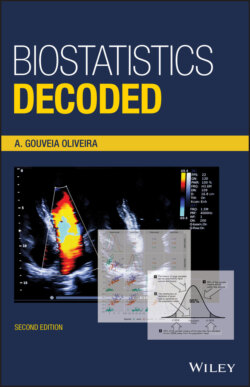Читать книгу Biostatistics Decoded - A. Gouveia Oliveira - Страница 24
1.16 Properties of the Normal Distribution
ОглавлениеThe normal distribution has many interesting properties, but we will present just a few of them. They are very simple to understand and, occasionally, we will have to call on them further on in this book.
First property. The normal curve is a function solely of the mean and the variance. In other words, given only a mean and a variance of a normal distribution, we can find all the values of the distribution and plot its curve using the equation of the normal curve (technically, that equation is called the probability density function). This means that in normally distributed attributes we can completely describe their distribution by using only the mean and the variance (or equivalently the standard deviation). This is the reason why the mean and the variance are called the parameters of the normal distribution, and what makes these two summary measures so important. It also means that if two normally distributed variables have the same variance, then the shape of their distribution will be the same; if they have the same mean, their position on the horizontal axis will be the same.
Second property. The sum or difference of normally distributed independent variables will result in a new variable with a normal distribution. According to the properties of means and variances, the mean of the new variable will be, respectively, the sum or difference of the means of the two variables, and its variance will be the sum of the variances of the two variables (Figure 1.26).
Figure 1.26 Properties of the normal distribution.
Third property. The sum, or difference, of a constant to a normally distributed variable will result in a new variable with a normal distribution. According to the properties of means and variances, the constant will be added to or subtracted from its mean, and its variance will not change (Figure 1.26).
Fourth property. The multiplication, or division, of the values of a normally distributed variable by a constant will result in a new variable with a normal distribution. Because of the properties of means and variances, its mean will be multiplied, or divided, by that constant and its variance will be multiplied, or divided, by the square of that constant (Figure 1.26).
Fifth property. In all normally distributed variables, irrespective of their means and variances, we can say that about two‐thirds of the observations have a value lying in the interval defined by the mean minus one standard deviation to the mean plus one standard deviation (Figure 1.27). Similarly, we can say that approximately 95% of the observations have a value lying in the interval defined by the mean minus two standard deviations to the mean plus two standard deviations. The relative frequency of the observations with values between the mean minus three standard deviations and the mean plus three standard deviations is about 99%, and so on. Therefore, one very important property of the normal distribution is that there is a fixed relationship between the standard deviation and the proportion of values within an interval on either side of the mean defined by a number of standard deviations. This means that if we know that an attribute, for example, height, has normal distribution with a population mean of 170 cm and standard deviation of 20 cm, then we also know that the height of about 66% of the population is 150–190 cm, and the height of 95% of the population is 130–210 cm.
Recall what was said earlier, when we first discussed the standard deviation: that its interpretation was easy but not evident at that time. Now we can see how to interpret this measure of dispersion. In normally distributed attributes, the standard deviation and the mean define intervals corresponding to a fixed proportion of the observations. This is why summary statistics are sometimes presented in the form of mean ± standard deviation (e.g. 170 ± 20).
Figure 1.27 Relationship between the area under the normal curve and the standard deviation.
